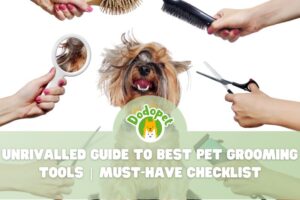Pet grooming is an important aspect of keeping your animal pet healthy and happy. Grooming your pet on a regular basis not only keeps them looking their best, but it also helps avoid a variety of health issues such as matting, skin infections, and parasites. You can save time and money with pet grooming at home by learning how to groom your pet at home while also guaranteeing your pet’s comfort and happiness.
Why Should You Groom Your Pet at Home?
Grooming your pet at home has several advantages:
- Convenience: You can groom your pet whenever it suits your schedule.
- Bonding: Grooming provides an opportunity to strengthen the bond between you and your pet.
- Cost-effective: Professional grooming services can be expensive, so grooming at home can save you money in the long run.
- Reduced stress: Some pets may feel anxious or stressed when taken to a grooming salon, so grooming at home can help alleviate their anxiety.
- Control: You have full control over the products and techniques used on your pet, ensuring their safety and comfort.
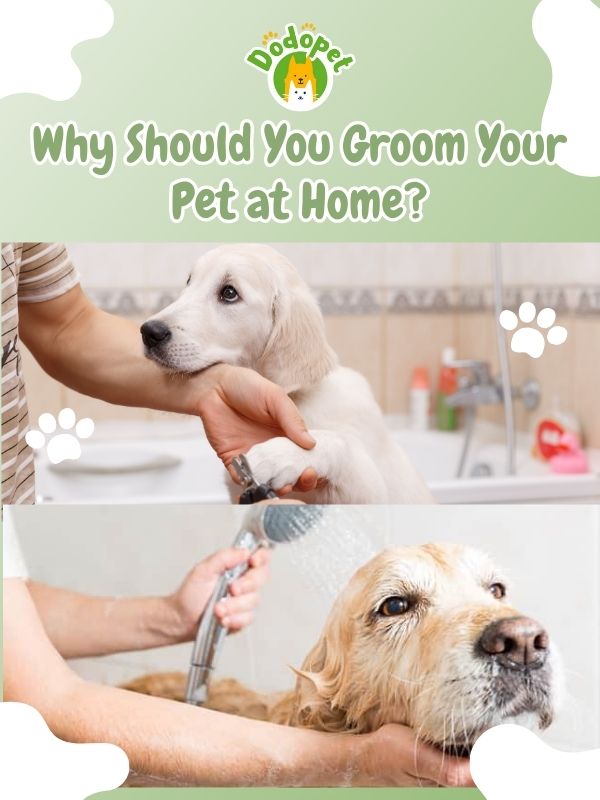
Why Should You Groom Your Pet at Home
A Guide to Different Breeds’ Grooming Requirements
Different breeds have unique grooming requirements based on their coat type, length, and individual characteristics. To ensure your pet’s well-being and keep them looking their best, it’s crucial to understand and meet their specific grooming needs.
Dog Breeds
- Short-Haired Breeds (e.g., Labrador Retriever, Beagle):
- Short-haired dogs require minimal grooming.
- Regular brushing helps reduce shedding and keeps their coat healthy.
- Occasional baths are sufficient.
- Long-Haired Breeds (e.g., Shih Tzu, Afghan Hound):
- Long-haired dogs need daily brushing to prevent matting and tangling.
- Regular baths with appropriate dog shampoo are necessary.
- Trimming their hair around the eyes, ears, and paws may be required.
- Double-Coated Breeds (e.g., Husky, German Shepherd):
- Double-coated dogs shed heavily seasonally. Regular brushing during shedding seasons is essential to remove loose fur.
- Bathe them when necessary, but not too frequently, to avoid stripping natural oils from their coat.
- Pay extra attention to grooming the undercoat to prevent matting.
- Curly-Haired Breeds (e.g., Poodle, Bichon Frise):
- Curly-haired dogs require regular professional grooming, including trimming and shaping.
- Brushing is necessary to prevent matting and tangling.
- Baths should be frequent, and the use of hypoallergenic shampoos can help maintain their curls.
- Hairless Breeds (e.g., Chinese Crested, Xoloitzcuintli):
- Hairless dogs need protection from the sun and cold weather.
- Regular moisturizing to prevent dry skin is essential.
- Bathing should be done with mild, hypoallergenic products to prevent skin irritations.
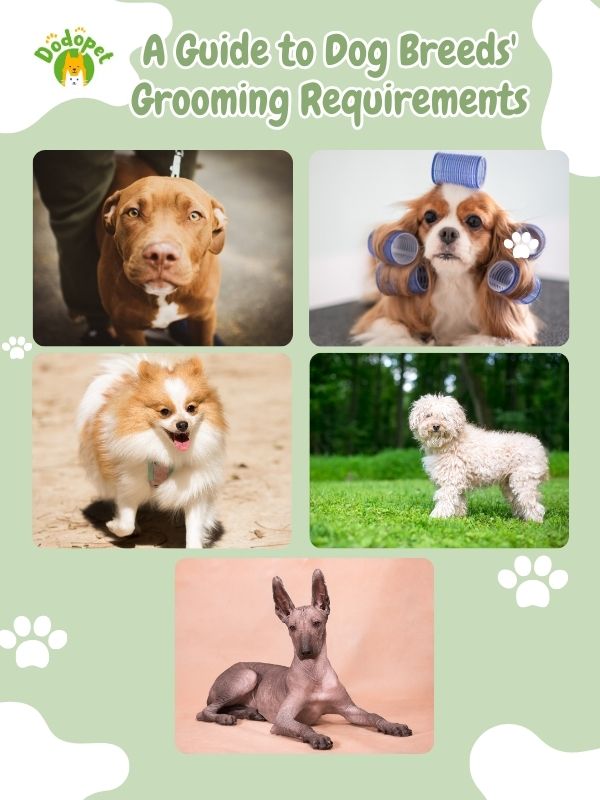
A Guide to Dog Breeds’ Grooming Requirements
Cat Breeds
- Short-Haired Cats (e.g., Domestic Shorthair):
- Short-haired cats are relatively low-maintenance in terms of grooming.
- Brushing can help reduce shedding and hairballs.
- Occasional baths may be needed, but most cats groom themselves.
- Long-Haired Cats (e.g., Persian, Maine Coon):
- Long-haired cats require daily brushing to prevent matting and hairballs.
- Regular baths are essential to maintain their coat’s health and appearance.
- Pay attention to their eyes, as some long-haired breeds are prone to tear staining.
- Sphynx Cats:
- Despite being hairless, Sphynx cats need regular bathing to remove oils and prevent skin issues.
- Protect their sensitive skin from sunburn and extreme temperatures.
- Rex Cats (e.g., Cornish Rex, Devon Rex):
- Rex cats have unique curly coats that need regular grooming to prevent matting.
- Bathing can help maintain their coat’s texture and cleanliness.
- Siamese Cats and Oriental Breeds:
- Siamese and Oriental breeds have sleek, short coats that are low-maintenance.
- Brushing to reduce shedding and regular ear cleaning is usually sufficient.
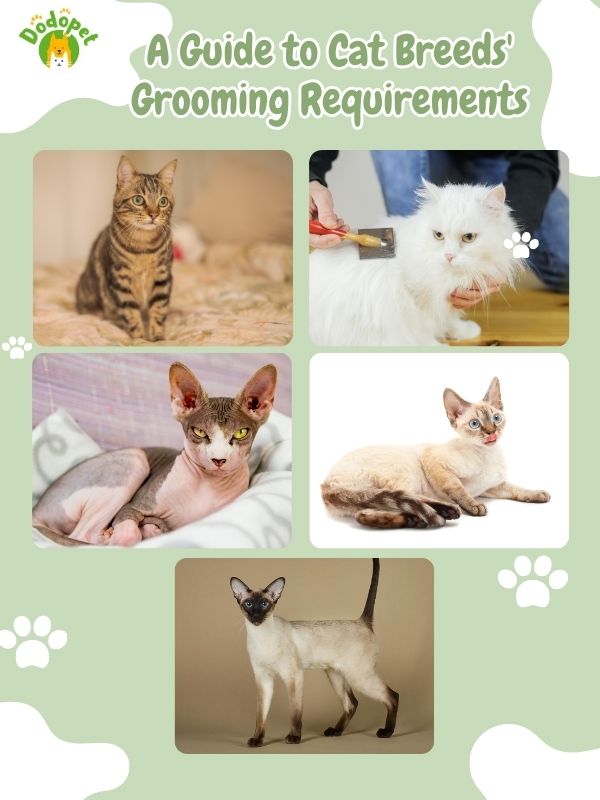
A Guide to Cat Breeds’ Grooming Requirements
Essential Tools for Pet Grooming
Before you start grooming your pet at home, it’s important to gather the necessary tools. Here are some essential items you’ll need:
Grooming Tools for Pet Grooming At Home
Invest in high-quality grooming tools that are suitable for your pet’s specific needs. These may include:
- Brushes and combs: Choose brushes and combs that are appropriate for your pet’s coat type, such as slicker brushes for removing loose hair and mats, and wide-toothed combs for detangling.
- Nail clippers: Use nail clippers designed for pets to trim their nails safely and prevent overgrowth.
- Ear cleaner: Keep your pet’s ears clean and free from wax buildup with a gentle ear cleaner.
- Toothbrush and toothpaste: Regularly brushing your pet’s teeth helps maintain good oral hygiene and prevents dental issues.
- Grooming scissors: Use grooming scissors to trim your pet’s fur, especially around sensitive areas like the face and paws.
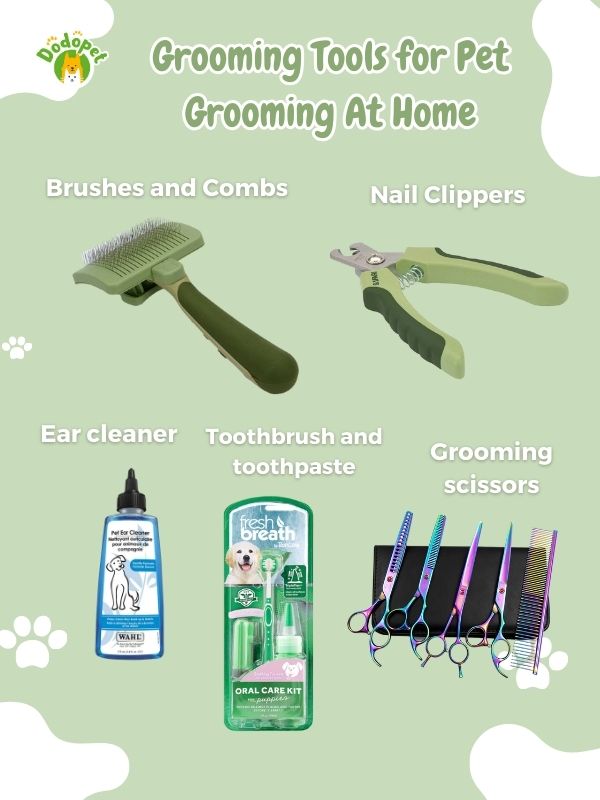
Grooming Tools for Pet Grooming At Home
Cleaning Supplies for Pet Grooming At Home
Ensure you have the following cleaning supplies on hand:
- Pet-friendly shampoo: Choose a mild, hypoallergenic shampoo formulated specifically for pets to avoid skin irritation.
- Towels: Have a few towels ready to dry your pet after bathing.
- Cotton balls: Use cotton balls to clean your pet’s ears and remove any excess moisture.
- Styptic powder: In case of accidental nail trimming too close to the quick, styptic powder helps stop bleeding.
- Pet-safe disinfectant: Clean your grooming tools and surfaces with a pet-safe disinfectant to prevent the spread of bacteria and germs.
Preparing for Pet Grooming At Home
Before you begin the grooming process, it’s important to prepare your pet and create a calm and comfortable environment. Follow these steps:
Step 1: Choose the Right Time
Pick a time when your pet is relaxed and not hungry or tired. Avoid grooming immediately after meals or vigorous exercise.
Step 2: Familiarize Your Pet with the Tools
Introduce your pet to the grooming tools gradually. Let them sniff and explore the tools before using them. This helps reduce anxiety and fear.
Step 3: Create a Calm Environment
Find a quiet and well-lit area in your home where you can groom your pet without distractions. Play soft music or use calming scents to create a soothing atmosphere.
Step 4: Reward Your Pet
Positive reinforcement is key to making grooming a positive experience for your pet. Offer treats and praise throughout the grooming process to reward good behavior.
Step 5: Take Breaks
If your pet becomes stressed or anxious during grooming, take short breaks to allow them to relax. This helps prevent overwhelming them and maintains their trust.
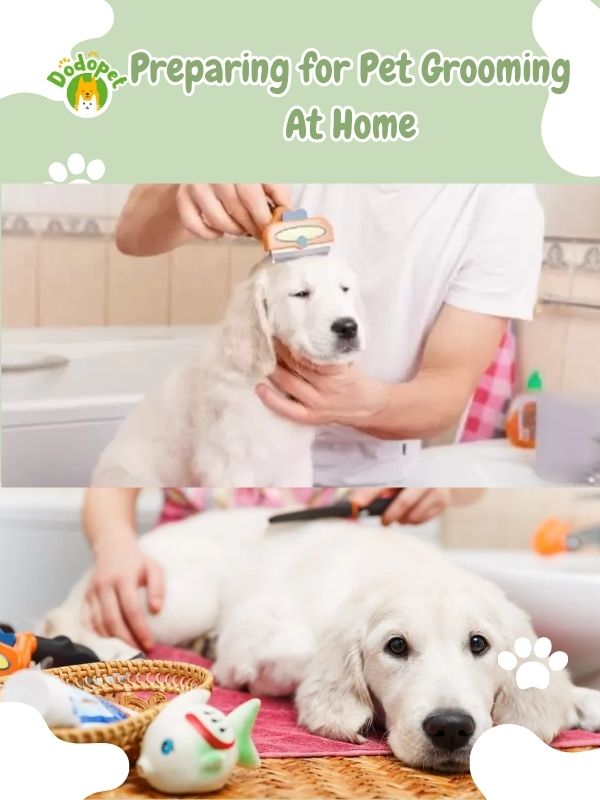
Preparing for Pet Grooming At Home
Grooming Techniques for Different Pets
Each pet has unique grooming needs based on their breed, coat type, and individual characteristics. Here are some expert tips for grooming different types of pets:
Dogs require regular grooming to keep their coats healthy and free from mats. Follow these tips:
- Brush your dog’s coat daily to remove loose hair and prevent matting.
- Bathe your dog using a gentle shampoo formulated for dogs. Be sure to rinse thoroughly to avoid skin irritation.
- Trim your dog’s nails regularly, taking care not to cut into the quick.
- Clean your dog’s ears using a pet-friendly ear cleaner and cotton balls.
- Regularly brush your dog’s teeth using a toothbrush and toothpaste designed for dogs.
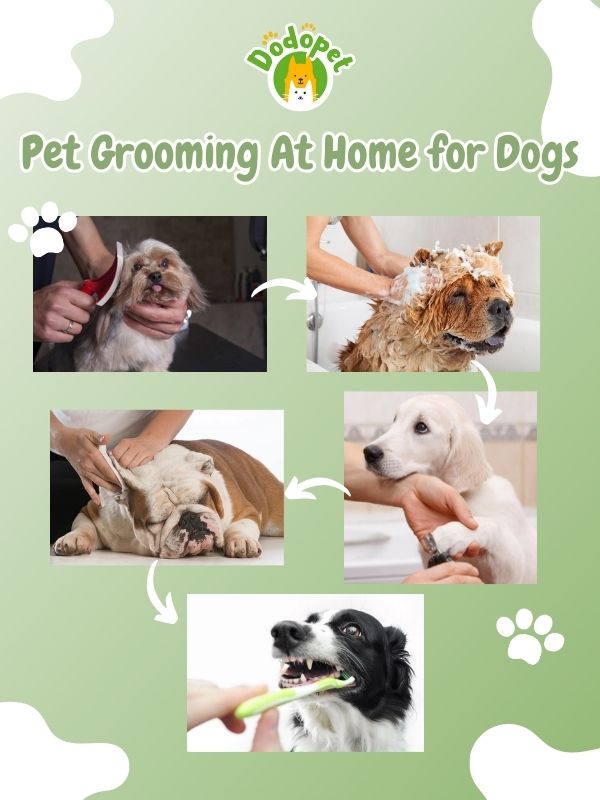
Pet Grooming At Home for Dogs
Pet Grooming At Home for Cats
Cats are known for their grooming habits, but they may still need some assistance. Here’s how to groom your cat:
- Brush your cat’s coat regularly to remove loose hair and prevent hairballs.
- Use a cat-specific shampoo if necessary, but most cats are self-cleaning and do not require frequent baths.
- Trim your cat’s nails regularly to prevent scratching and overgrowth.
- Clean your cat’s ears using a pet-friendly ear cleaner and cotton balls.
- Introduce tooth brushing gradually to maintain your cat’s dental health.
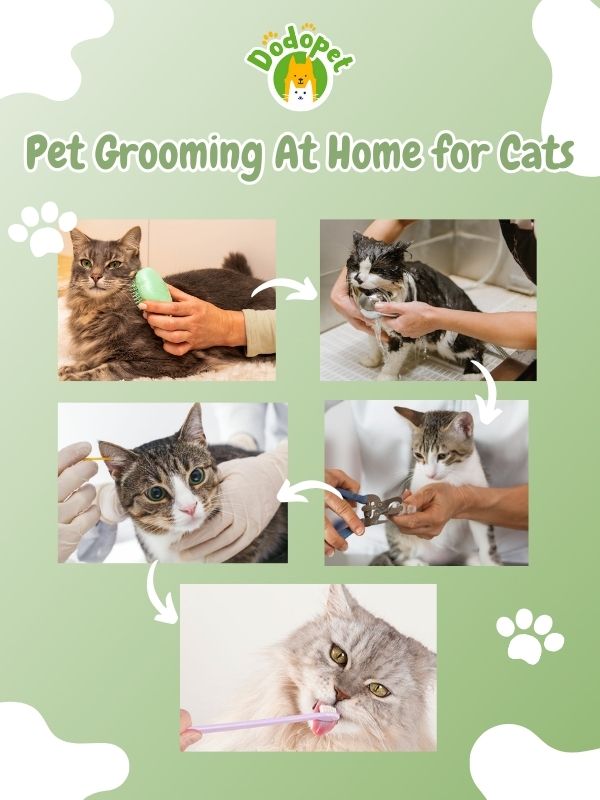
Pet Grooming At Home for Cats
Pet Grooming At Home for Small Animals
Small animals such as rabbits, guinea pigs, and hamsters also benefit from regular grooming. Here are some tips:
- Brush your small animal’s fur gently to remove loose hair and prevent matting.
- Use a small animal-specific shampoo if necessary, but most small animals do not require frequent baths.
- Trim your small animal’s nails regularly to prevent overgrowth.
- Clean your small animal’s ears using a pet-friendly ear cleaner and cotton balls.
- Consult a veterinarian for specific dental care instructions for your small animal.
Troubleshooting Common Issues of Pet Grooming At Home
Even with proper grooming techniques, you may encounter some common issues. Here’s how to troubleshoot them:
Matted Fur
If your pet’s fur becomes matted, follow these steps:
- Use a detangling spray or conditioner to loosen the mats.
- Gently comb through the mats using a wide-toothed comb or slicker brush.
- If the mats are severe, consider seeking professional help to prevent discomfort or injury to your pet.
Ear Infections
If your pet develops an ear infection, take the following steps:
- Consult a veterinarian for proper diagnosis and treatment.
- Clean your pet’s ears regularly using a pet-friendly ear cleaner to prevent future infections.
- Avoid inserting anything deep into your pet’s ear canal, as this can cause injury.
Overgrown Nails
If your pet’s nails become overgrown, follow these tips:
- Trim the nails carefully using pet nail clippers, taking care not to cut into the quick.
- If you’re unsure, consult a veterinarian or a professional groomer for assistance.
- Regular nail trimming helps prevent discomfort and potential injuries.
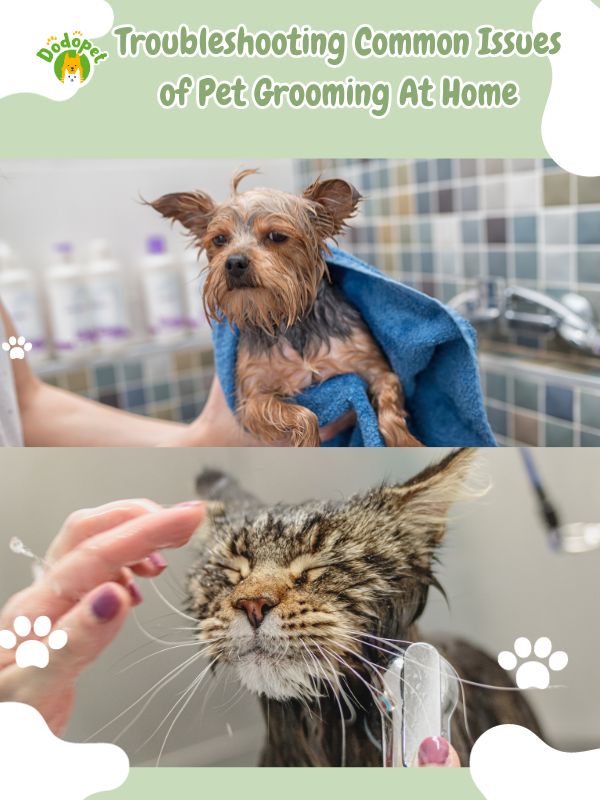
Troubleshooting Common Issues of Pet Grooming At Home
Conclusion
Mastering pet grooming at home is a valuable skill that benefits both you and your furry friend. By following expert tips and techniques, using the right tools, and creating a calm environment, you can ensure a positive grooming experience for your pet. Remember to tailor your grooming routine to your pet’s specific needs and seek professional help when necessary. With regular grooming, your pet will not only look their best but also enjoy improved overall health and well-being.




